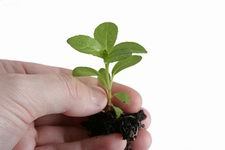Article by Steven Gray
Organic gardening is the practice of growing vegetables, herbs and fruits relying only things found in nature. An organic gardener aspires to work in harmony with natural systems and to minimize and continually replenish any of the resources the garden consumes. The organic gardener prefers to use natural and organic materials and methods, while trying to avoid using practices and synthetic chemicals that may be detrimental to his or the environment's health. As a reward, organic gardens can be both attractive and productive – and it's simpler than you think!
Organic gardening differs from "conventional" gardening mainly in what regards fertilization and pest control. If pests are present, it is important to assess whether or not they are causing sufficient damage that action must be taken against them. Plants such as marigolds, sunflowers, and dill can attract beneficial insects that prey on pests that would otherwise damage nearby plants. Some plants have a tendency to ward off specific pests, especially when planted next to susceptible plants. They do this by emitting chemicals from their roots or leaves, called allelochemicals, which repel pests. Also, birds, ladybugs and praying mantises are to be considered the gardener's best friends when it comes to insect control.
The soil is a resource that is biologically active and dynamic, providing your plants with nutrients, water and oxygen. Organic matter (which forms from the decayed plant material) is an essential ingredient in fertile soils. Organic matter improves soil tilth and prevents soil compaction and crusting, while increasing the water holding ability of the soil and providing a more favourable soil environment for earthworms and beneficial microorganisms. Organic matter also slows erosion and, in later stages of decay, organic matter releases nitrogen and other nutrients needed by the growing crops. Organic gardeners, to ensure the greatest chances for success, should have their garden soil tested for pH and nematodes. Most garden plants grow best in soil with a pH ranging from 6.0 to 6.8. Remember that because most soil life and plant roots are located in the top 6 inches of soil, you should concentrate on this upper layer. Plants that are happy with their growing conditions will be healthier and happier than plants that are stressed!
Gardening is often as much about planning as it is about growing practices. To plant your plants, dig a hole just as deep and at least twice as wide as the root ball of the plant. When planting, remember to also take into consideration the plant's size at maturity. Newly purchased plants should be planted during the late evening or on a cloudy day. Once you have planted all of your plants, give the entire garden a three inch layer of organic mulch, such as shredded bark, hay, chopped leaves or grass clippings. Remember that plants that are adapted to your zone's climate and conditions are better able to grow without a lot of attention or input!
Even though organic gardens can take time to establish and require a certain amount of dedication, the organic way to garden is safer, cheaper, and more satisfying!










kateM - 15 years ago
Good ideas but…”a three-inch layer of organic mulch”…take care. Do not put fresh grass clippings on or near seedlings – they get very hot.